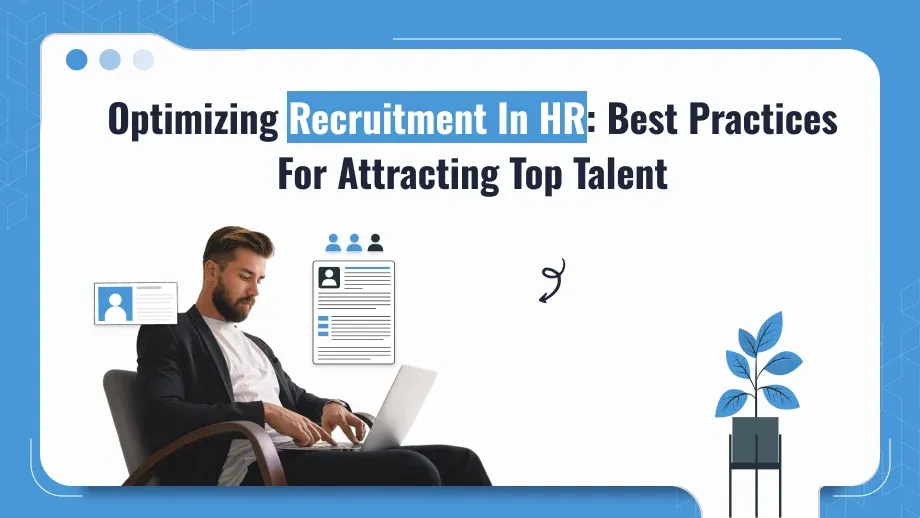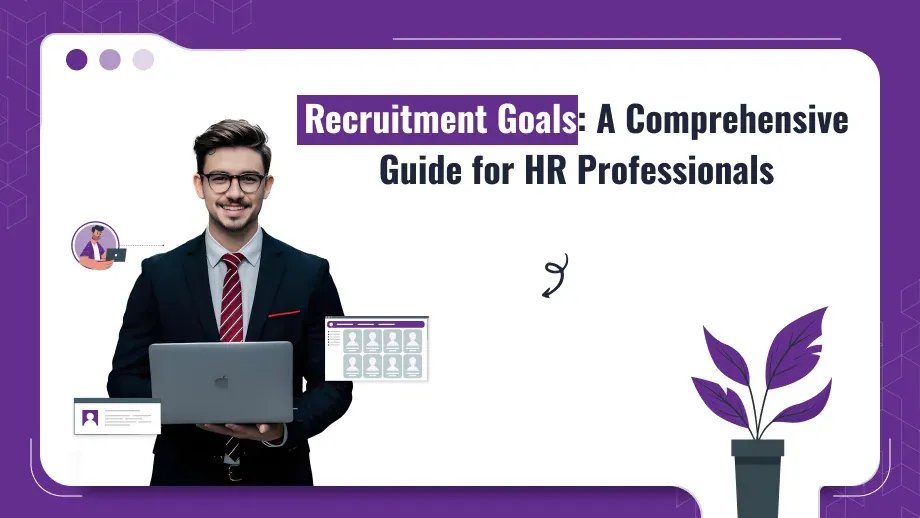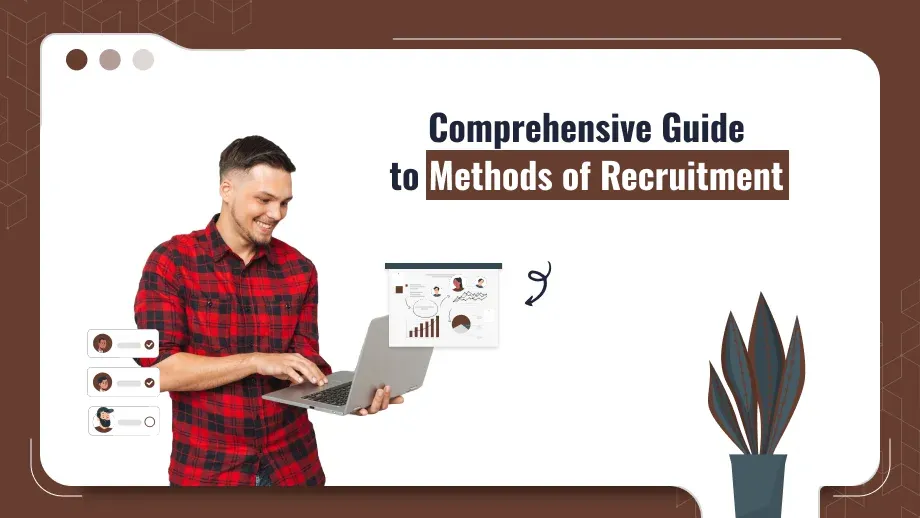
Recruitment in HR is very fundamental to any organization as it serves as the ground by which a capable and engaged workforce is established. Without proper recruitment, companies may not find the talent to be needed for growth and innovativeness. In HR, the process of recruitment is more than just filling a vacant slot. It is finding individuals whose skills and values reflect the long-term goals of the company.
This article will discuss what is fundamental to recruitment within HR, the types of recruitment, and tips on the improvement of the recruitment cycle in HR. If you seek to improve your recruitment strategies or streamline the process, you will find this guide particularly helpful in building a strong workforce.
What is Recruitment in HR?
Recruitment in HR is the process that attracts, selects, and onboards appropriate talent into your organization. It plays a very pivotal role in the success of an entire company since the correct people are brought aboard for the realization of current needs and to meet future needs too. So, what exactly does the recruitment process in HR mean and why is this process important?
At the bottom, recruitment in HR represents identifying potential job openings, developing potential candidates, and selecting some of them who are appropriately suited for the role. What happens after the hire? The recruitment cycle continues because it involves helping new people get adjusted to the organization and their jobs. At its core, HR ensures that the company maintains staffing requirements over some time through a process of recruitment.
According to HR, recruitment is not just filling up jobs. It creates a talent pipeline for the company’s strategic goals. For that reason, recruitment in HR is very structured and methodical; every step- from a job description, down to interviews toward the right fit both the candidate and the company deserve.
Recruiting Types in HR
There are a couple of categories of recruitment in HR, made to fit specific needs dependent on the goals of the organization, the resources available, and the urgency of the needs. Here are some examples of common recruitment types;
Internal Recruitment
Internal recruitment is the transfer or promotion of existing employees to a new position. The advantage of this is saving time and money because these applicants already know the culture. Such recruitment in HR method is effective for maintaining and developing the top performers in the organization.
External Recruitment
External recruitment is the process of getting new employees from outside the company. This can be done through job boards, social media, or recruitment agencies. External recruitment is often required when the company requires new skills or perspectives that are not available internally. recruitment marketing plays a vital role here, as this helps promote the company to attract external talent.
Campus Recruitment
This is recruitment where companies target fresh graduates or interns from colleges and universities. Organizations often use this approach in filling entry-level positions. Campus recruitment is ideal for organizations that want to introduce new thinking and creativity in their teams.
Referral Recruitment
The referred people have a higher success ratio since they are recommended by someone who knows about the company and the skills of the applicant.
Referral recruitment uses the networks of the existing employees to source appropriate candidates. Referred candidates often have a higher success rate because they come recommended by someone who understands both the company and the candidate’s capabilities.
The kind of recruitment used depends on the needs of the company, time constraints, and resources. Internal recruitment might be ideal when positions require experience in the company, while external recruitment would be effective for specific types of skills.
Ready to optimize your recruitment in HR?
Explore effective solutions to improve your hiring process and build a strong team.
Steps of the Recruiting Process in HR
The recruitment process in HR, being a system of recruitment of the best talents of an organization, involves several steps of the recruitment process, which enable an organization to identify and onboard the right candidate in an organization. Below is the recruitment process in HR:
Identifying Hiring Needs
This entails the identification of the need for a new position arising from company growth, internal promotion, or leaving the company. This step pinpoints the specific skills and qualifications required to achieve the desired outcome for the company.
Creating Job Descriptions
The job description should elaborate, but, at the same time, be concise. A good job description illustrates responsibilities, skills and qualifications required, and expectations related to the role. A well-written job description will attract the right candidate to the job.
Sourcing Candidates
This involves the use of various sourcing strategies, including candidates, job boards, social media, internal postings, and employee referrals. Major sourcing can be supplemented with powerful employer branding and Recruitment Marketing.
Screening and Shortlisting
Once the applications are received, screening starts with the review of some resumes, preliminary interviews, and sifting through less-than-qualified applicants within the applicant pool. The Applicant Tracking Systems can also ease filtration processes as well.
Interviewing
After shortlisting, shortlisted candidates will be interviewed. There are a variety of rounds of interviews which can include phone screenings, technical assessments, and face-to-face interviews. This process is not only meant to test the candidate’s skill but also to judge whether he or she can fit into the culture of the organization.
Selection and Offer
Once a candidate is chosen, the next step is extending a formal offer. This stage includes negotiating the salary and terms of employment. Clear communication during this phase ensures that the candidate feels valued and informed.
Onboarding
At this stage, the newcomer is integrated into the organization. Recruitment of hr onboarding process is important for longer-term retention and productivity.
All these processes are undertaken to make the recruitment cycle of HR exhaustive enough to arrive at choosing the most suitable candidate. By streamlining these processes, companies can make it more efficient and decrease hiring time.
Tips for Successful Recruitment in HR
Successful recruitment in HRM requires a mix of strategy, technology, and a focus on both candidate and organizational needs. Here are more actionable tips to ensure your recruitment process is efficient and effective:
Develop Clear and Concise Job Descriptions
In the domain of HRM, effective recruitment calls for a combination of strategy, technology, and an approach to both the candidate and organizational needs. More specific actionable tips are discussed next to ensure your recruitment challenge is efficient and effective in its delivery: Clear, concise job descriptions.
Use Recruitment Technology to Streamline Processes
With technology, such as ATS and Recruitment Databases, you can significantly reduce hands-on work in the recruiting process. It helps minimize the tediousness of automated tasks, like resume screenings and interview scheduling, hence giving recruiters time to emphasize strategic aspects like cultural fits and managing candidate relationships. You can also generate reports on recruitment reports to have an idea of the movement and to enhance decision-making concerning the recruitment procedure.
Communicate Transparently with Candidates
Clear communication is one of the most important aspects of recruitment, including keeping candidates informed at every step, building trust, and creating a great candidate experience. This includes updates after interviews, giving constructive feedback, and being clear about timelines.
Use Recruitment Metrics to Refine Your Strategy
It means the recruitment in HR metrics time-to-hire, cost-per-hire, and acceptance of offers help visualize your recruitment performance. Periodic analysis of these metrics will be useful to identify bottlenecks in the process that require improvement in the same. Your strategy then becomes adaptable and efficient.
Focus on Both Skills and Cultural Fit
While technical skills may be the foundation in hiring, equally important is ensuring that you hire people who can fit your company culture. This can be ascertained by using personality assessments, structured interviews, and feedback from several stakeholders regarding whether the candidate will thrive in your organization. Long-term success is often driven by cultural alignment as much as skills.
Create a Positive Candidate Experience
The candidate experience should be on top at every touchpoint from application to onboarding. Let the application process be very user-friendly; give timely feedback and make interviews smooth as silk. Even if selected, positive experiences can become a brand ambassador and improve the reputation of the company you work for.
Build a Strong Talent Pipeline
Rather than waiting for the react-to-fills, ensure that you have a talent pipeline building that you can draw on when a spot is available. This means developing relationships with people who wouldn’t necessarily be a fit for roles you are trying to fill in the present but maybe they would fit a good role in the future. This proactive reduces the time to hire and provides more constant access to the right talent.
Utilize Employee Referrals
Employee referrals are considered one of the most effective ways of sourcing candidates. They understand the company culture and are in the best position to recommend those who not only possess the right qualifications but are also likely to fit in with the team. You may want to implement a referral program that rewards employees for recommending successful hires.
Offer Competitive Compensation and Benefits
The most obvious value salary has is now a comprehensive package due to one of the reasons, namely health insurance, flexible work arrangements, or professional development opportunities. Other offers you make should therefore be able to offer a level playing ground in terms of comparison with other organizations in your industry.
Prioritize Diversity and Inclusion
A diverse workforce brings new ideas and innovation, which is very important for business growth. Hire people in such a manner that hiring practices are inclusive through blind recruitment techniques, helping to minimize bias, and writing job descriptions that encourage diverse candidates to apply. You can also include diverse hiring panels to ensure a well-rounded evaluation process.
Leverage Recruitment Marketing for Employer Branding
A strong employer brand attracts higher-quality candidates more easily. Use Recruitment Marketing strategies to demonstrate what your company stands for and how it benefits your workforce on social media, job boards, and your career page. Show positive testimonials from employees and their stories so that your company becomes an attractive place to work.
Train Hiring Managers and Recruiters
Good recruitment requires well-trained hiring managers and recruit HR. Train sessions on how to conduct successful interviews, avoid unconscious bias, and improve candidate assessments. This helps ensure consistency and professionalism throughout the hiring process, thereby making better recruitment decisions.
Adapt to Remote Recruitment
The concept of working remotely will be on an upward trend and is probable to be seen everywhere. The entire process of recruitment in HR will have to change in hiring and recruiting employees to work remotely. In your hiring process, see to it that virtual interviews and assessments are conducted. Use online testing tools that can test your candidates in terms of working remotely, and ensure them to get on board effectively so they feel connected right from the first day of work. More remotely manageable and controllable recruitment can be offered by using cloud based HRMS software.
Conclusion
Proper recruitment in HR, not just filling up gaps but building a team toward organizational success. Recruitment needs to be aligned with business objectives; the latest technology utilized and skillset and culture to fit in the same team. This will ultimately result in attracting top talent while improving retention as well.
In terms of saving more time and resources, there is stronger workforce production while not forgetting that retention indeed starts during recruitment, for positive experiences during onboarding are truly the foundation when keeping your new hires productive and on track in the long haul. It will be a robust, sustainable recruitment system for your company if you build it on constant improvement of your recruitment in HR and data-driven decisions.





